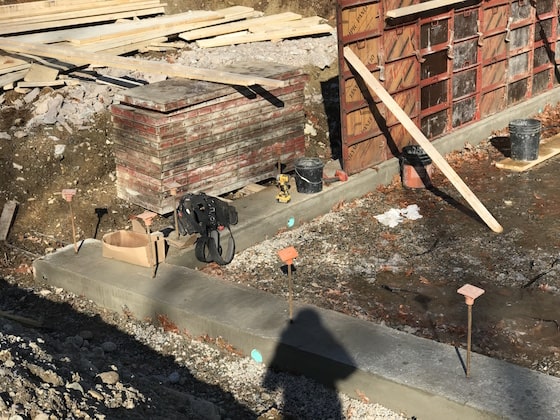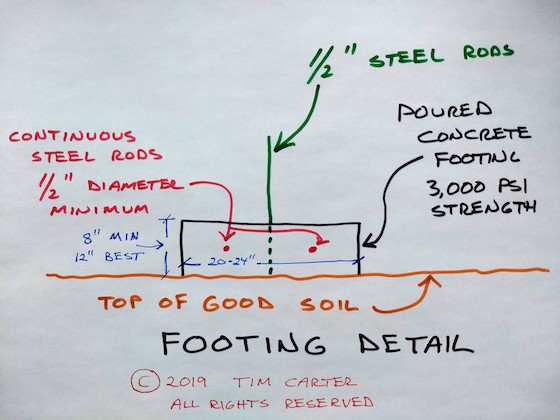Foundation Footing Detail

Foundation Footing Detail - It's All About Great Soil & Steel
"That's what a house footer does. Its job is to provide a nice flat and level surface to set foundation wall panels and to spread out the weight of the entire house onto the ground."
Tim Carter - Look below
DEAR TIM: I stopped by my new home construction site the night before the foundation footer was going to be poured to start to take photos. I saw several white pipes inside the forms and wondered what they were for.
Will these compromise the strength of the footer since the concrete thickness will be less where they're located? The steel rods are suspended above the ground too. Is that right? What's the exact purpose of the footer and will it support the house if a hollow spot develops under it for some reason? Cindy S., Buffalo, NY

Related Columns
Poured or Concrete Block Foundation? Which is Best?
DEAR CINDY: Congratulations to you on your new home. It's exciting to build a home. I remember building my new home for my wife, and it was fascinating to see our dreams turn into reality each day. You're also very, very smart to take photos of each step of the process.
With digital photography, you can take thousands of photos for free. Take countless photos, many up close, of each detail of the job. Even though you might not know what you're looking at, a professional, at a later date, can gather very important data from your photos.
When possible, include something in the photo for scale. It can be a small plastic ruler, a set of car keys or a common soda pop can or bottle of water. This is very important when taking photos of defects in things like a concrete slab crack, a scratch on siding or a door, etc.
Let's talk about foundation footers. A footer got its name from our own anatomy. Think about it. Your foot is that part of your body that's normally in contact with the earth during the day. It also helps support you and spreads out your body weight on the ground or a floor.
What Does a Footing Do?
That's what a house footer does. Its job is to provide a nice flat and level surface to set foundation wall panels and to spread out the weight of the entire house onto the ground.
Think of a knife and butter. If you try to cut through butter with a knife blade laid flat across the butter, you don't get far. If you put the edge of the knife on the butter and push down, you cut right through it.
Imagine if narrow 8-inch-wide foundation walls were poured directly on the soil. There's a very good possibility the foundation would start to slice down through the soil over time. That would be very bad.

All that’s missing is the concrete for this foundation footing. The white pipe allows water to pass from under the house to the low spot on the lot. Photo Credit: Tim Carter
Should Sleeve Pipes Be In a Footing Design?
The pipes that you see are a very good thing. That tells me the builder or architect knows how to alleviate tiny artesian water wells inside the basement of your home. Those pipes will allow any ground water that might build up under your basement slab to drain, by gravity, to the soil around your home. The pipes will not compromise the strength of the footer or its ability to spread the weight of your house onto the ground.
Should Drain Tile Be Outside the Footing?
If the builder installs great foundation drain tile outside the footer once it's poured and this pipe continues beyond the house to a low point on your lot where it comes to the surface as the ground falls away, any and all groundwater around and under your slab will naturally drain away and not enter your basement.
What is the Best Lot for Foundation Drainage?
This is why I always tried to purchase and build on lots where at least one part of the lot was lower in elevation than the bottom of the footer. I wanted Mother Nature to provide part of my basement waterproofing for free. When you can drain the water to the low spot of a lot using gravity instead of pumping it out of a sump, you're so much better off.
Why Are Steel Reinforcing Rods Important?
The steel rods you see are supposed to be encased in the concrete. The steel provides tens of thousands of pounds of tensile strength to the footers. Concrete is very strong when you compress it, but when you bend or try to stretch it, it only has ten percent of the strength it has when compressed.
If the ground below the footer does settle, the steel rods will help hold the footer together. The footer itself is not designed to bridge large hollow spots or soft spots in the ground or soil. Think about how steel I-beams and floor joists are made. The vertical web of a steel I-beam is what allows it to support things. The same is true for a floor joist. If you lay a floor joist flat, it bends easily.
Your tall concrete foundation walls are just like the webs of a steel I-beam. This is why it's very important for there to be continuous steel bars about 16 inches from the bottom of the foundation wall and 12 or 16 inches down from the top of the wall inside the poured concrete.
This steel holds, in most cases, the foundation wall together in the event the soil beneath it starts to fail. I hope your plans call for four total steel bars in the foundation. I'd love for them to be 5/8-inch in diameter too.
Based on the photo you sent me, it appears the foundation contractor is not cutting any corners. I'll bet that he'll be putting in the required steel in the foundation, but go ahead and ask him what he's got planned just to be sure.
Column 1100
One Response to Foundation Footing Detail